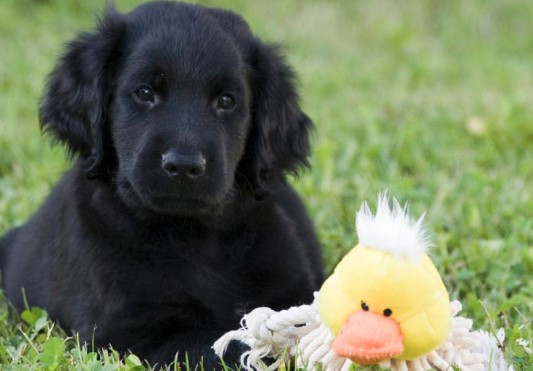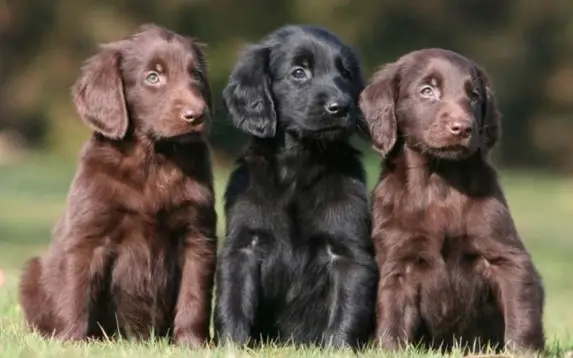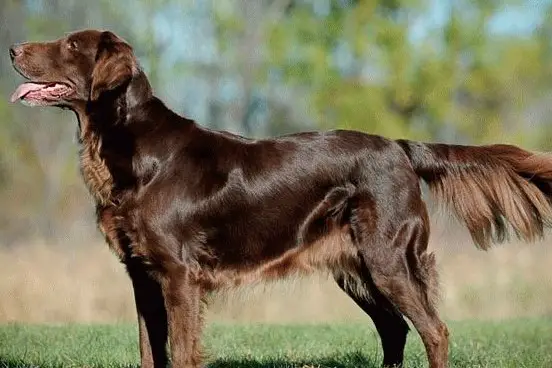The Flat Retriever breed is a very positive dog in all respects, which is now rare used for hunting. Although, the breed retains its hunting instincts today. More often, these animals are used as excellent companions that can adapt to a variety of living conditions.
Character
The Flat-Coated Retriever can surprise anyone. It is how two completely different dogs get along. On the one hand, they are hardworking, active, and hardy hunters who have an excellent instinct and are not afraid of water.
On the other hand, breeders note that the Flat-Coated Retriever never grows out of puppyhood. A funny, foolish, and even somewhat infantile dog, in old age he will still arrange little pranks with the same pleasure. You should be prepared for this since not all owners can tolerate such a pet’s character.
The responsive and quick-witted Flat-Coated Retriever easily assimilates new information and understands what the owner wants. It is quite easy to train representatives of this breed. However, the skills are still the same, so the owner should have at least minimal experience in dog training.
The Flat-Coated Retriever needs company, he quickly gets used to the family and is ready to follow the owner everywhere. Loneliness negatively affects the character of the dog, it becomes nervous and uncontrollable.
Flat-Coated Retriever quickly finds a common language with children. But if you plan to purchase a puppy for a child, then it is better to choose its relative – a Golden Retriever or a Labrador.
The Flat-Coated Retriever is a sociable and sociable dog. If he was socialized in a timely manner, there will be no problems.
Care
The Flat-Coated Retriever has a medium-length coat. It requires weekly brushing with a medium brush. After each walk, it is advisable to examine the dog, to clean it of dirt.
It is also important to periodically clean your pet’s ears and eyes.
Conditions of detention
The Flat-Coated Retriever is active, he cannot sit still, especially at a young age. This dog needs at least 2-3 walks a day, for a total duration of at least two hours. Moreover, it should be not just a calm promenade, but running, games and all kinds of exercises, physical exercises.
Check your animal’s ears and eyes. It is recommended to clean if necessary. Do not forget to treat the animal’s fur with a blood-sucking insect repellent. Always, even in spite of the treatment, after returning from the forest, carefully examine the pet’s head for adhered ticks.
Monitor the condition of your teeth and nails. The former needs to be cleaned periodically, the latter should be trimmed in time. Straight Coated Retriever puppies are trained to daily hygiene from childhood. Be sure to teach the growing dog to wash or wipe his paws after a walk. Do not let the animal rush into the room. The impression the dog will never pass beyond the hallway with dirty paws, patiently waiting for the attention of the owner.
Pay due attention to your pet’s fitness. Considering nature and natural instincts, create a physical activity for the dog. The main characteristic of the breed is great diligence, animal breeds love to work and do it with benefit.
Pros
- versatility;
- obedient character;
- pretentiousness;
- cheerfulness.
Cons
- training requires firmness of character;
- the need for frequent long walks and physical activity.
The dog is practically flawless, and the only great difficulty lies in wait for the owners of the flat – dogs are extremely sensitive. If you count in a positive way, there is rather a dignity. During educational work, sensitivity interferes, especially if the owner has an explosive, impatient character.

We have had Flatcoats since 1983 and they have all worked on local shoots. We did lose one at 3 years, not from cancer, but have also had a couple which died from cancer at 10. The last one we lost was 14 also not from cancer! At present we have two aged 9 and 4 and can’t imagine ever being without one.